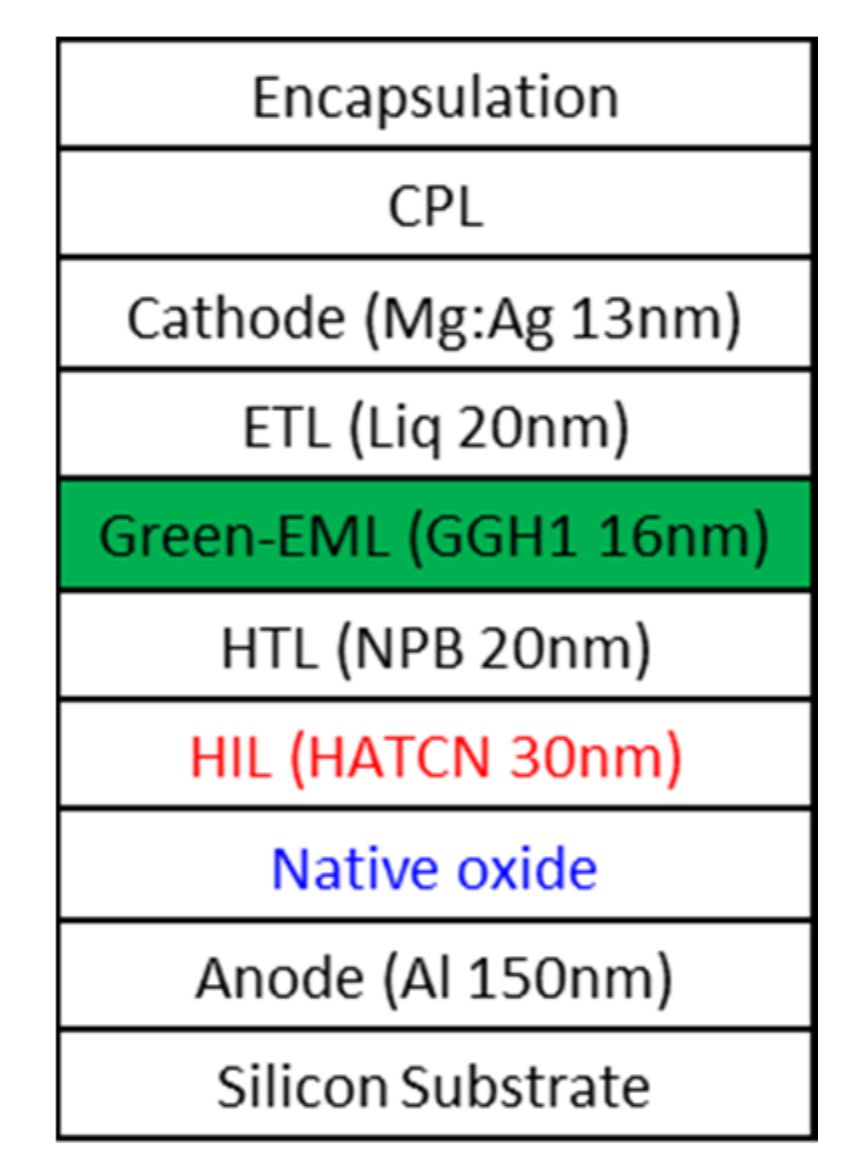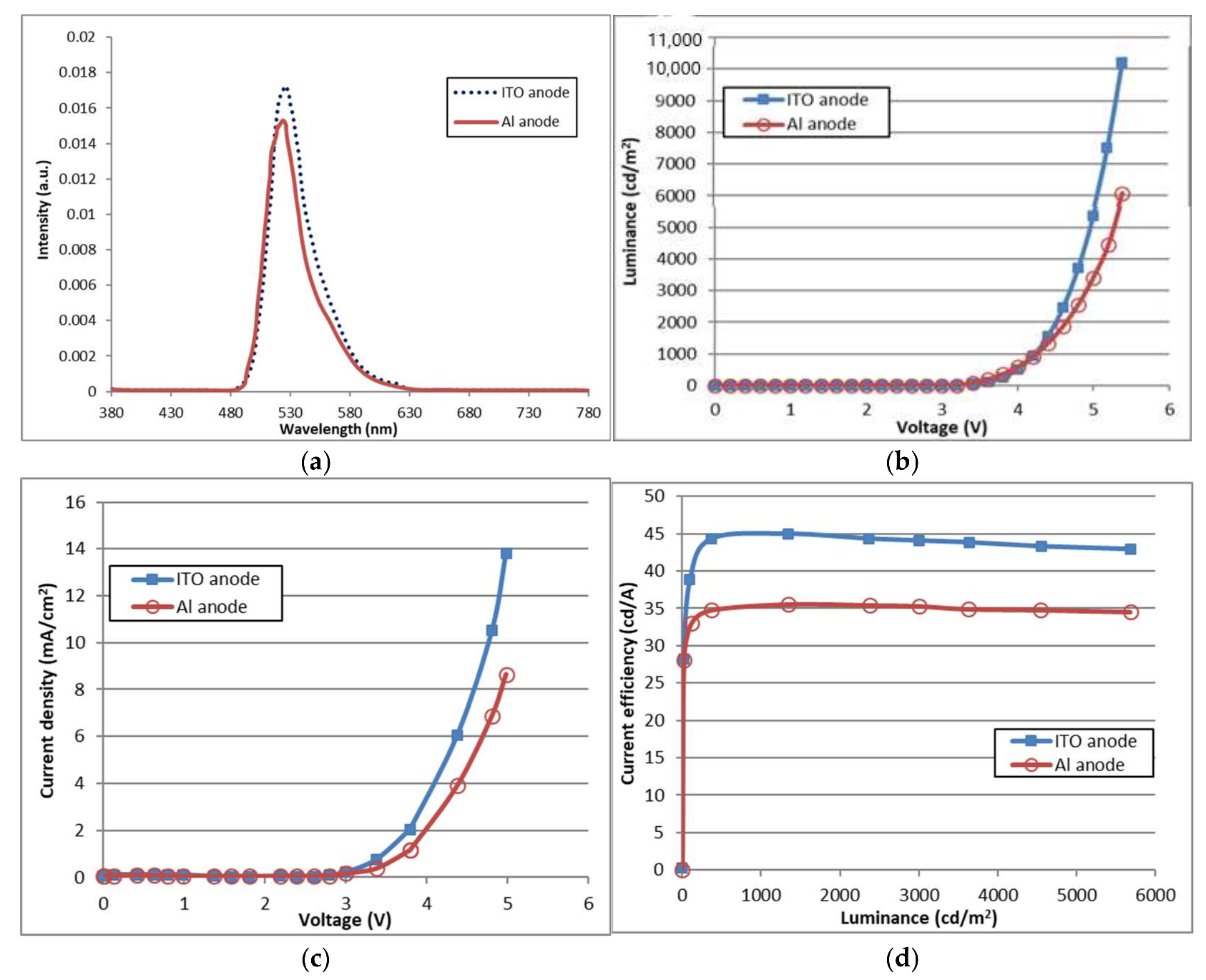Enhanced Hole Injection Characteristics of a Top Emission Organic Light-Emitting Diode with Pure Aluminum Anode
Abstract
:1. Introduction
2. Materials and Methods
3. Results and Discussion
4. Conclusions
Author Contributions
Funding
Conflicts of Interest
References
- Kim, C.; Kim, K.; Kwon, O.; Jung, J.; Park, J.K.; Kim, D.H.; Jung, K. Fine metal mask material and manufacturing process for high-resolution active-matrix organic light-emitting diode displays. J. Soc. Inf. Disp. 2020, 28, 668–679. [Google Scholar] [CrossRef]
- Vogel, U.; Kreye, D.; Richter, B.; Bunk, G.; Reckziegel, S.; Herold, R.; Scholles, M.; Törker, M.; Grillberger, C.; Amelung, J.; et al. 8.2: Bi-Directional OLED Microdisplay for Interactive HMD. SID Symp. Dig. Tech. Pap. 2008, 39, 81–84. [Google Scholar] [CrossRef]
- Levy, G.; Evans, W.; Ebner, J.; Farrell, P.; Hufford, M.; Allison, B.; Wheeler, D.; Lin, H.; Prache, O.; Naviasky, E. An 852×600 pixel OLED-on-silicon color microdisplay using CMOS subthreshold-voltage-scaling current drivers. IEEE J. Solid State Circuits 2002, 37, 1879–1889. [Google Scholar] [CrossRef]
- Chen, S.; Deng, L.; Xie, J.; Peng, L.; Xie, L.; Fan, Q.; Huang, W. Recent Developments in Top-Emitting Organic Light-Emitting Diodes. Adv. Mater. 2010, 22, 5227–5239. [Google Scholar] [CrossRef]
- Peng, H.J.; Zhu, X.L.; Yu, X.M.; Wong, M.; Sun, J.X.; Kwok, H.S. Efficiency improvement of phosphorescent organic light-emitting diodes using semitransparent Ag as anode. Appl. Phys. Lett. 2006, 88, 033509. [Google Scholar] [CrossRef]
- Lu, M.-H.; Weaver, M.S.; Zhou, T.X.; Rothman, M.A.; Kwong, R.C.; Hack, M.; Brown, J.J. High-Efficiency top-emitting organic light-emitting devices. Appl. Phys. Lett. 2002, 81, 3921–3923. [Google Scholar] [CrossRef]
- Park, M.J.; Kim, S.K.; Pode, R.; Kwon, J.H. Low absorption semi-transparent cathode for micro-cavity top-emitting organic light emitting diodes. Org. Electron. 2018, 52, 153–158. [Google Scholar] [CrossRef]
- Jean, F.; Mulot, J.-Y.; Geffroy, B.; Denis, C.; Cambon, P. Microcavity organic light-emitting diodes on silicon. Appl. Phys. Lett. 2002, 81, 1717–1719. [Google Scholar] [CrossRef]
- Gohri, V.; Hofmann, S.; Reineke, S.; Rosenow, T.; Thomschke, M.; Levichkova, M.; Lüssem, B.; Leo, K. White top-emitting organic light-emitting diodes employing a heterostructure of down-conversion layers. Org. Electron. 2011, 12, 2126–2130. [Google Scholar] [CrossRef]
- Hatton, R.A.; Willis, M.R.; Chesters, M.A.; Rutten, F.J.M.; Briggs, D. Enhanced hole injection in organic light-emitting diodes using a SAM-derivatised ultra-thin gold anode supported on ITO glass. J. Mater. Chem. 2002, 13, 38–43. [Google Scholar] [CrossRef]
- Kanai, K.; Koizumi, K.; Ouchi, S.; Tsukamoto, Y.; Sakanoue, K.; Ouchi, Y.; Seki, K. Electronic structure of anode interface with molybdenum oxide buffer layer. Org. Electron. 2010, 11, 188–194. [Google Scholar] [CrossRef]
- Qiu, C.F.; Peng, H.J.; Chen, H.Y.; Xie, Z.L.; Wong, M.; Kwok, H.S. Top emitting OLED using praseodymium oxide coated platinum as hole injectors. IEEE Trans. Electron. Devices 2004, 51, 1207–1210. [Google Scholar] [CrossRef]
- Wu, J.; Hou, J.; Cheng, Y.; Xie, Z.; Wang, L. Efficient top-emitting organic light-emitting diodes with a V2O5 modified silver anode. Semicond. Sci. Technol. 2007, 22, 824–826. [Google Scholar] [CrossRef]
- Ventsch, F.; Gather, M.C.; Meerholz, K. Towards organic light-emitting diode microdisplays with sub-pixel patterning. Org. Electron. 2010, 11, 57–61. [Google Scholar] [CrossRef]
- Ji, Y.; Ran, F.; Xu, H.; Shen, W.; Zhang, J. Improved performance and low cost OLED microdisplay with titanium nitride anode. Org. Electron. 2014, 15, 3137–3143. [Google Scholar] [CrossRef]
- Lee, H.; Cho, H.; Byun, C.-W.; Kang, C.-M.; Han, J.-H.; Lee, J.-I.; Kim, H.; Kim, M.; Cho, N.S. Device Characteristics of Top-Emitting Organic Light-Emitting Diodes Depending on Anode Materials for CMOS-Based OLED Microdisplays. IEEE Photonics J. 2018, 10, 1–9. [Google Scholar] [CrossRef]
- Lee, J.; Li, P.; Kung, H.; Lu, Z. Highly efficient top-emission organic light-emitting diode on an oxidized aluminum anode. J. Appl. Phys. 2019, 125, 145501. [Google Scholar] [CrossRef]
- Zhou, X.; Pfeiffer, M.; Huang, J.S.; Blochwitz-Nimoth, J.; Qin, D.S.; Werner, A.; Drechsel, J.; Maennig, B.; Leo, K. Low-Voltage inverted transparent vacuum deposited organic light-emitting diodes using electrical doping. Appl. Phys. Lett. 2002, 81, 922–924. [Google Scholar] [CrossRef]
- Dobbertin, T.; Kroeger, M.; Heithecker, D.; Schneider, D.J.; Metzdorf, D.; Neuner, H.; Becker, E.; Johannes, H.-H.; Kowalsky, W. Inverted top-emitting organic light-emitting diodes using sputter-deposited anodes. Appl. Phys. Lett. 2003, 82, 284–286. [Google Scholar] [CrossRef]
- Dodabalapur, A.; Rothberg, L.J.; Jordan, R.H.; Miller, T.M.; Slusher, R.E.; Phillips, J.M. Physics and applications of organic microcavity light emitting diodes. J. Appl. Phys. 1996, 80, 6954–6964. [Google Scholar] [CrossRef]
- Ali, T.A.; Khayrullin, I.I.; Vazan, F.; Ziesmer, S.A.; Prache, O.; Jones, G.W.; Ghosh, A.P. 59.2: High Performance Top Emitting OLED Devices. SID Symp. Dig. Tech. Pap. 2007, 38, 1691–1694. [Google Scholar] [CrossRef]
- Kim, Y.-K.; Kim, J.W.; Park, Y. Energy level alignment at a charge generation interface between NPB and HATCN. Appl. Phys. Lett. 2009, 94, 43. [Google Scholar]
- Lee, J.-H.; Kim, J.-J. Interfacial doping for efficient charge injection in organic semiconductors. Phys. Status Solidi A 2012, 209, 1399–1413. [Google Scholar] [CrossRef]
- Yoo, S.J.; Chang, J.-H.; Lee, J.-H.; Moon, C.-K.; Wu, C.-I.; Kim, J.-J. Formation of perfect ohmic contact at indium tin oxide/N,N′-di(naphthalene-1-yl)-N,N′-diphenyl-benzidine interface using ReO3. Sci. Rep. 2014, 4, 3902. [Google Scholar] [CrossRef] [Green Version]



| Parameters | Device with Al Anode | Device with ITO Anode | Notes |
|---|---|---|---|
| Current efficiency (cd/A) | 35 | 45 | @1000 nit |
| Driving voltage (V) | 4.2 | 3.8 | @1000 nit |
| Peak wavelength (nm) | 525 | 525 | |
| CIE color coordination | (0.22, 0.71) | (0.23, 0.71) |
Publisher’s Note: MDPI stays neutral with regard to jurisdictional claims in published maps and institutional affiliations. |
© 2021 by the authors. Licensee MDPI, Basel, Switzerland. This article is an open access article distributed under the terms and conditions of the Creative Commons Attribution (CC BY) license (https://creativecommons.org/licenses/by/4.0/).
Share and Cite
Park, C.Y.; Choi, B. Enhanced Hole Injection Characteristics of a Top Emission Organic Light-Emitting Diode with Pure Aluminum Anode. Nanomaterials 2021, 11, 2869. https://doi.org/10.3390/nano11112869
Park CY, Choi B. Enhanced Hole Injection Characteristics of a Top Emission Organic Light-Emitting Diode with Pure Aluminum Anode. Nanomaterials. 2021; 11(11):2869. https://doi.org/10.3390/nano11112869
Chicago/Turabian StylePark, Chan Young, and Byoungdeog Choi. 2021. "Enhanced Hole Injection Characteristics of a Top Emission Organic Light-Emitting Diode with Pure Aluminum Anode" Nanomaterials 11, no. 11: 2869. https://doi.org/10.3390/nano11112869
APA StylePark, C. Y., & Choi, B. (2021). Enhanced Hole Injection Characteristics of a Top Emission Organic Light-Emitting Diode with Pure Aluminum Anode. Nanomaterials, 11(11), 2869. https://doi.org/10.3390/nano11112869






